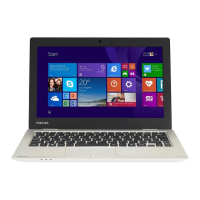
Do you have a question about the Toshiba Satellite CL10 Series and is the answer not in the manual?
| Processor | Intel Celeron N2840 |
|---|---|
| RAM | 2GB DDR3L |
| Display | 1366 x 768 |
| Operating System | Windows 8.1 |
| Graphics | Intel HD Graphics |
| Battery | Lithium-ion |
| Wireless | 802.11 b/g/n, Bluetooth 4.0 |
| Ports | USB 2.0, USB 3.0, HDMI, Headphone/Microphone combo jack |
Explains the meaning and use of various safety symbols in the manual.
Explains additional icons used for technical notes, hints, and definitions.
Tips for choosing an optimal location to use the computer for comfort and performance.
Recommendations for creating a suitable workspace, including ventilation and protection from environmental factors.
Advice on ergonomics and posture for comfortable computer use throughout the day.
Specific advice on posture, desk setup, and chair adjustments for optimal user comfort.
Guidance on connecting and using external peripherals for enhanced productivity.
Tips on improving typing efficiency and comfort, including wrist posture and keyboard shortcuts.
Importance of regular breaks and posture changes to prevent fatigue and strain.
Advice for using the notebook effectively in various mobile environments like airports and during travel.
Recommendations for safely carrying the notebook to prevent physical strain and damage.
Information on where to find assistance for workstation adjustments and ergonomic concerns.
Essential safety instructions to prevent personal injury and damage to the computer.
Guidance on ensuring proper ventilation to prevent overheating and system damage.
Steps and considerations for the initial setup of the computer system.
Information and warnings regarding the installation of additional memory modules.
Instructions for safely connecting the computer to AC power for operation and charging.
Procedure for fully charging the computer's main battery before initial use.
Steps for powering on the computer and performing the initial operating system setup.
How to navigate and utilize the Windows Start menu for various tasks and settings.
Benefits and process of registering the computer with Toshiba for updates and support.
Instructions on how to properly shut down the Windows operating system and the computer.
Steps for restarting the computer to apply updates or resolve minor issues.
How to put the computer into Sleep mode to conserve power while retaining current state.
Guidance on connecting external devices like monitors or storage to expand computer functionality.
Overview of utilities for restoring the computer's internal storage drive to its original state.
Step-by-step instructions for creating a bootable USB recovery drive for system restoration.
Process for using a created recovery drive to restore the computer's system files and drivers.
How to reset the computer to its factory settings, with options to keep or remove personal files.
Instructions on how to use the touchpad for pointer control, selection, and scrolling.
How to modify touchpad sensitivity and behavior for improved usability and to prevent accidental input.
Method to temporarily disable or re-enable the touchpad, useful during typing.
General steps for connecting various external devices using USB or other ports.
Connecting external monitors, televisions, or projectors to the computer for extended display.
Specific instructions for connecting displays via the HDMI port.
Steps for connecting external monitors or projectors using the RGB port.
How to manage display output modes (PC screen only, duplicate, extend) for multiple monitors.
Tips for optimizing picture quality on external displays by adjusting video settings.
How to access and modify various system settings to personalize the computer's behavior.
General advice on cleaning and moving the computer to maintain its condition.
Procedures and precautions for safely cleaning the computer's exterior and display.
Steps to ensure all activity ceases before moving the computer to prevent data loss or damage.
Instructions on how to use an optional security cable lock to protect the computer from theft.
Essential advice for efficient computing, including saving work and avoiding data loss.
Overview of the computer's keyboard layout, including character, control, and special Windows keys.
Explanation of the function keys (F1-F12) and their use with the FN key for system functions.
Details on the functions of the Windows key and Application key for system navigation.
Information about touch screen capabilities and interaction methods.
How to use touch gestures like tap, touch & hold, and drag for screen interaction.
How to access and adjust settings for the computer's pointing device, such as the touchpad or mouse.
Guide on launching applications from the Start menu, All apps list, or search field.
Critical advice on frequently saving work to prevent data loss from unexpected shutdowns or power failures.
Importance and methods for backing up important files to external media for data safety.
Information on accessing Toshiba's websites for product support, updates, and technical assistance.
Explanation of the computer's power-saving features designed for energy efficiency.
Information on using the computer's internal battery for power when away from an AC outlet.
Overview of preset power management options for optimizing system performance and battery life.
Instructions for charging the computer's main battery using the AC adapter.
How to check the battery's charge status using system indicator lights.
Recommended actions when the computer's battery level is critically low.
How to configure notifications for low battery levels and set automatic power-saving actions.
Various methods and tips to extend the computer's battery operating time.
How to select or customize power plans to balance performance and power savings.
Details on the eco power plan for maximizing battery time by adjusting system performance.
Information on when a new battery might be needed and how to obtain one.
Essential safety precautions and maintenance tips for prolonging battery life and ensuring safe operation.
Guidance on environmentally responsible disposal of the computer and its components.
Recommendations for using the computer safely and conveniently while traveling.
An overview of the Windows desktop environment and its primary functions.
Explanation of key desktop elements like icons, taskbar, and notification area.
What icons represent and how to interact with them on the desktop.
How to use the Start button to access the Start menu and its features.
How to use Task view to manage multiple open windows and virtual desktops.
Instructions for creating and managing multiple virtual desktops for better organization.
Information on accessing and using the Windows Store to download applications.
Detailed guide on setting up a Wi-Fi connection and establishing internet access.
How to connect the computer to various networks, including Wi-Fi access points.
Information on using the computer's audio capabilities, including speakers and microphones.
How to record audio using the internal or external microphone with the Voice Recorder application.
Connecting audio output devices like speakers or headphones to the computer.
How to use the built-in web camera for taking pictures, recording videos, and video conferencing.
Information on supported memory card types and how to use the reader.
Steps for correctly inserting memory cards into the reader.
Procedure for safely ejecting memory cards from the reader.
Utility for monitoring and managing power savings, tracking energy consumption.
Tool for setting and managing supervisor and user passwords for system security.
Utility for configuring BIOS settings, display options, boot priority, and other system configurations.
Utility for receiving notifications about software updates, firmware, and documentation.
Steps for resolving issues like applications freezing or stopping responding.
Troubleshooting steps for issues encountered during the computer's startup process.
How to identify and fix problems related to the Windows operating system's functionality.
How to access and use Windows startup options for system troubleshooting and repair.
Troubleshooting common issues related to slow internet connections or browser errors.
Steps to diagnose and resolve problems concerning the computer's power adapter, cord, and battery.
Troubleshooting steps for keyboard issues, including driver updates and power cycles.
Procedure for resetting the computer's power system to resolve hardware glitches.
How to uninstall and automatically reinstall the keyboard driver to fix functionality problems.
How to restore the system to a previous state to fix issues caused by recent changes.
Troubleshooting steps for common touchpad issues and how to adjust settings.
How to modify touchpad sensitivity and behavior for improved usability and to prevent accidental input.
Solutions for common display issues, such as a blank screen or incorrect display output.
Steps to troubleshoot a blank computer screen, possibly due to display auto-off or priority settings.
How to diagnose and resolve issues with hard drives or external storage media.
Procedure for running disk error-checking to scan for and repair drive damage.
Steps to improve hard disk performance by running Disk Defragmenter for fragmented files.
Troubleshooting steps for resolving issues with the computer's built-in web camera.
How to test the web camera's functionality using the default application.
Troubleshooting steps for audio problems related to hardware setup and software configuration.
How to use the Windows audio troubleshooter to diagnose and fix sound playback issues.
Steps to configure audio output devices and set default speakers for sound playback.
How to uninstall and reinstall the audio driver to resolve sound-related problems.
Instructions for finding and installing the most recent audio drivers from Toshiba's support website.
Troubleshooting common issues encountered with printer connectivity and functionality.
General troubleshooting tips for resolving issues with Wi-Fi connectivity and network access.
Essential requirements and steps for establishing an internet connection using an ISP and appropriate hardware.
How to connect to a wireless network and verify connection status.
How to interpret network icon indicators to diagnose connection problems.
Steps to verify the physical hardware components of the internet connection, including modem and router.
How to uninstall and reinstall the wireless network adapter driver to fix connectivity issues.
Using the PING command to check network adapter and TCP/IP functionality.
Information on using Toshiba Service Station to update computer components and drivers.
Tips for maintaining computer health and productivity, emphasizing regular work saving.
Creating restore points to easily revert the system to a previous stable state.
Detailed steps for backing up user data and the complete computer system using Windows features.
Best practices and precautions for safely installing new hardware and software applications.
Guidance on seeking further technical assistance if problems persist after troubleshooting.
Information on how to contact Toshiba support for technical assistance and product information.
Lists the system functions that can be modified or launched using TOSHIBA Function keys.
How to adjust screen brightness using specific Function keys.
Using Function keys to cycle through display output options for external monitors.
How to enable or disable the touchpad using a specific Function key for typing comfort.
Explanation of Function keys used for controlling media playback, such as track skipping and volume.
How to use Function keys to enable or disable audio output mute.
How to enable or disable the Wi-Fi antenna and switch between wireless modes using Function keys.
A list of common acronyms and their meanings found in the user's guide.
Definitions of various technical terms related to computer hardware, software, and networking.
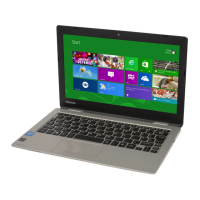
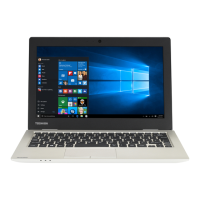

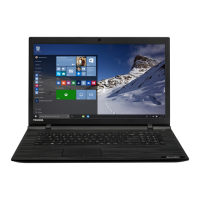
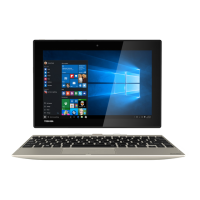
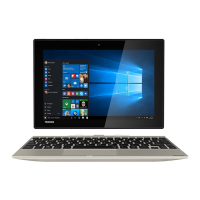
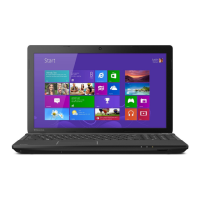

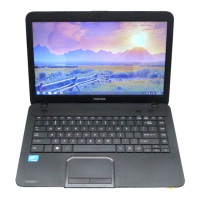

